Nimue Brown's Blog, page 329
February 7, 2016
Transport isn’t spiritual?
“Oh no, if you’re walking as transport, that isn’t spiritual.”
I was in a conversation with someone who had expressed an enthusiasm for embodied spirituality, and was told this. My idea of spiritual walking – namely that all walking is, or can be spiritual – was apparently wrong. I don’t know how many other people believe this – that to be spiritual, an activity has to be redundant in practical terms – but it makes no sense to me. How can we talk about embodied spirituality, but only have it apply when we aren’t occupied with the physical realities of living? What it means is that Tai Chi and Yoga and standing meditations and walking that is deliberately constructed to be a spiritual exercise can be spiritual, but getting somewhere is excluded.
To do something that has no use to you may seem like a good act of dedication to the divine. Time and energy poured into an act that has no purpose other than to express adoration for the divine. If that’s your path, by all means, follow it, but it isn’t mine and never will be. Central to this is that I do not want this neat divide of sacred and profane. I don’t want to see some things as special and other bits as not special – for me this is intrinsic to embodied, experienced spirituality. All of the earth is sacred. Any act of engaging with the earth can therefore be sacred if we want it to be.
As a Pagan I want to engage spiritually with the physical realities of my existence. I want to live in my breath and my movement – something I don’t always do well. I want to live as greenly as I can – walking for me is part of being sustainable, and being sustainable to the best of my abilities is for me, a key act of Pagan dedication. I need to get places – to work the soil, to share bardic expressions, to buy food and clothes, to meet people. None of these things strike me as being intrinsically unspiritual aims. I seek relationship and survival.
There’s another aspect to this in that green living takes time. I cook from raw materials most days. I hand wash my clothes. I don’t have a car. Things that are the work of minutes for some people take me hours. This does not leave me with a vast amount of time and bodily energy to devote to doing spiritual things that serve no practical purpose. My choice to live lightly is in no small part a spiritual choice.
It doesn’t matter where I am or why I am walking or who I am with – I always pay a lot of attention to my surroundings, to the elements and the wildlife around me. Anyone who is walking can. I am more conscious of the exact shape of the land when I walk than when inside any mode of transport. I feel and acknowledge the wind, the sun, the night time – there’s conscious connection and presence for me. It doesn’t matter if I’ve popped out for a loaf of bread, or am coming back from a party – I could still see a fox, or hear an owl, and I’m alert to all of that.
To walk (or cycle) for transport is to make a big commitment to living lightly. Cars cause all sorts of problems – emissions, contribution to global climate change, wars fought over oil, noise pollution, air pollution, the need for roads and parking spaces requiring land to be covered in tarmac, the death toll of wildlife on the roads, the interruption and destruction of habitats for roads, the deaths of people on the roads… I think anything any of us can do to reduce this has to be good. It is not easy or convenient to do without a car in a culture that assumes car use as normal. It can be socially alienating and makes jobs and key infrastructure – like healthcare – much harder to access. It is, by any measure, a sacrifice.
But of course no one is selling expensive courses in getting from A to B on your own two feet. No exotic walking to work retreats, no walking to the supermarket gurus, and so on. It is ‘pedestrian’ with all that suggests to us. No one gets to be important by walking to where they need to be, and no one will be impressed by how special and spiritual you are if they see you doing it.
We evolved to get around by walking. We have this unusual body configuration precisely so that we can put one foot in front of the other to get where we need to be. Walking is ancestral, it is fundamental, it is intrinsic to being human. Walking to get stuff done is a major part of the history of our species. How can this not be spiritual?


February 6, 2016
Favourite Things – Retro politics and unblamable men
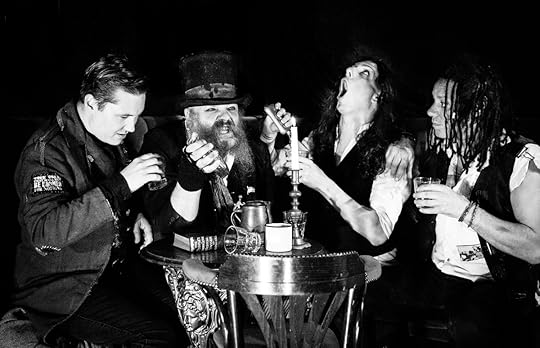 The theme for this year’s Steampunk Hands around the World is ‘Favourite things’ so I’m going to use today’s blog to talk about why I love retro-politics, and The Men That Will Not Be Blamed For Nothing. They are, for those of you who are as yet uninitiated, four chaps with punk influences, guitars, drums, a musical saw, comedy genius and a great willingness to make a lot of noise.
The theme for this year’s Steampunk Hands around the World is ‘Favourite things’ so I’m going to use today’s blog to talk about why I love retro-politics, and The Men That Will Not Be Blamed For Nothing. They are, for those of you who are as yet uninitiated, four chaps with punk influences, guitars, drums, a musical saw, comedy genius and a great willingness to make a lot of noise.
I shuffled into the idea of retro politics quite by accident, while writing Intelligent Designing for Amateurs. It’s a simple enough idea – talking about the politics of the past in order to say something about the present. It’s something The Men are exceedingly good at. In this period of despicable austerity, talking about Victorian England is a really good way of illustrating how backward we’re being, while being funny, and creating enough emotional distance to make it bearable. You wouldn’t go out to listen to a band sing about the terrible air pollution in London, but somehow a song about Victorian smog does exactly the same job while being funny.
One of my favourite songs on this score is Doing it for the Whigs, which pauses at one point for Andrew O’Neill to shout ‘That’s right, votes for women! Fucking get over it.’ I could go off on a long, long rant about the modern men who think women should not be allowed to vote, but I’ll stick with Andrew’s line. It’s charmingly to the point. Their ‘Charlie’ song works in a similar way, reflecting Victorian fury with Darwin suggesting they were all descended from apes, and here we are, all this time later and we’ve still got people pedalling intelligent design. I could get very depressed at our failure to progress, but I won’t, I’ll go and listen to Margate Fhtagn (didn’t we have a lovely time the day we met Cthulhu).
Modern politics are, for the greater part, bloody depressing. Retro politics makes it possible to laugh. And The Men that Will Not Be Blamed For Nothing are a very entertaining outfit, and a fantastic live act. I saw them at Exeter last December. They talked from the stage about the importance of community and getting skills that have a real use. They talked about deliberately keeping their ticket prices and merchandise costs as low as they can ‘so you don‘t have to exploit someone else to be able to afford our shit’. My kind of people, my kind of philosophy. Get angry, and have a laugh and change everything.
“The Men That Will Not Be Blamed For Nothing come from a past which probably never happened via a present they didn’t want.” Read more about them here – https://en.wikipedia.org/wiki/The_Men_That_Will_Not_Be_Blamed_for_Nothing
This is them on bandcamp – https://blamedfornothing.bandcamp.com/
More Steampunk Hands Around the World goodness here – https://airshipambassador.wordpress.c...


February 5, 2016
Open Art Surgery
When we do events, Tom and I quite often find there are people who would like to talk to us – or to other already in-print people – about their own work. We’re happy to do this, and it’s something we anticipate doing formally at Asylum this year (massive Steampunk event, August bank holiday, Lincoln). Next week (13th February 2016) we’ll be at Museum in the Park, in Stroud from 11am – 3pm, feel free to seek us out and ask us questions.
In the meantime, here are some FAQs that, to be honest, I’d rather not be dealing with at Open Art Surgeries, not least because there’s very little I can do to help you if I’m faced with one of these…
I had an idea for a book. This is lovely, and best of luck to you, but an idea for a book is not a book, and if I take on helping you to move that book from the idea stage to the writing stage it’s going to use up more time than I can spare. Learn about characters, plots, world building, dialogue, etc etc, and then try and write the book. If you want to talk to me, or anyone else about publishing, there’s absolutely no point even asking until you’ve established that you can write. Many people start their first novel and don’t finish it and go no further. Let’s find out if this is you or not before we talk.
I started a novel and I can’t finish it and I don’t know what to do! Don’t worry, this happens a lot. Most published authors have some failed attempts along the way. It is ok to ditch the first attempt and try something else, or re-write it in a different way – this is a learning process. It’s ok to feel stuck for a while. If you can get through this patch, you could be the sort of person who writes books. If you can’t get past it, you are not cut out for authoring.
Will you read my book? Probably not. If you’re a friend, or I’m really taken with what you’re doing, I might offer, but if you have to ask me, it’ll probably be a no. It’s a time issue. If you are going to ask me to read, be clear about what you’re asking for and why you think this will help you. If you’re looking for reviews and endorsements, I may say yes, if it’s clearly my sort of thing.
Can Tom do me some art? If your book is unwritten, and there is no budget for art, this is not a question to be asking. If you want to do a comic and don’t have an artist, you need to find an artist at the same career point as you, i.e. someone who has never done a comic and wants and author to work with. Art takes a lot of time, think carefully before you ask someone if they are willing to give you hours of working time for nothing when they could be being paid. They would have to love you a lot to say yes. Tip – if you want to re-use a piece of art someone’s already done, the chances are they will license it to you for something more affordable, that one’s always worth enquiring about.
My child wants to be an author/artist. Then make sure they have some means of earning a living during the long stretch of a creative career when you can’t get paying work and everyone expects you to give your stuff away for ‘exposure’. Currently the industry is a mess and creative people are sorely underpaid. We have no idea what the score will be in ten year’s time.
I can’t draw a stick figure. We hear this a surprising amount, and we don’t know why people feel the need to come and tell us this, but we can’t do much to help you except say this. Art is not magic, nor is writing. Mostly it comes down to graft. If you are willing to put in about ten thousand hours (on this, or any other thing you might not have mastered) you will probably master it. That’s all you have to do. Spend ten thousand hours drawing or writing and you’ll be a whole other person.
Can you put me in touch with X? Again, we may offer to hook you up with people if we think you are just what they were looking for. If you have to ask, we’re probably going to say no. If you think about someone else’s contact network as something to access and exploit, you’re on shaky ground. What we have is relationships with people built up over time, nourished by care, effort and attention. We aren’t going to give you their phone number unless we have a really good reason to do so.
If you’ve established that you can write, or draw, if you’re trying to figure out how to take your work, or your project to the next level, do come and talk to us. We may be able to offer advice and insights, and if we like what you’re doing and we can think of a way to help you, then we will.


February 4, 2016
Outlandish, magical and unlikely things
Books I have recently read…
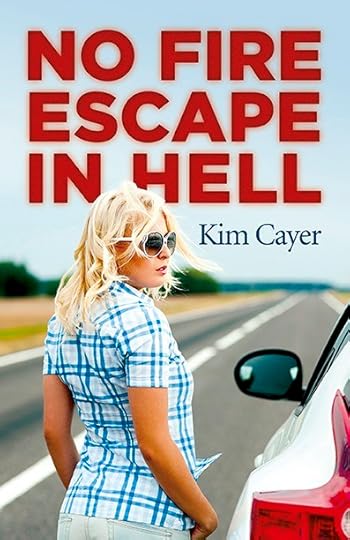 No Fire Escape in Hell- Kim Cayer. I picked this up because I really enjoyed Kim’s thoroughly mad tale ‘Lights, Camera, Dissatisfaction’ and her second novel is equally crazy and charming. Kim writes madcap middle aged romps, in which unlikely heroines with improbable ways of life face outrageous and bizarre challenges and somehow pull through. The heroine of No Fire Escape in Hell is trying to buy off her abusive husband so he’ll leave her be. To do this, she lives in her car while delivering singing telegrams to the Toronto area. Laugh out loud funny in places, but also a serious look at what it means to have nowhere to live, especially the social alienation it causes, and the way in which living with abuse can get you making insane choices.
No Fire Escape in Hell- Kim Cayer. I picked this up because I really enjoyed Kim’s thoroughly mad tale ‘Lights, Camera, Dissatisfaction’ and her second novel is equally crazy and charming. Kim writes madcap middle aged romps, in which unlikely heroines with improbable ways of life face outrageous and bizarre challenges and somehow pull through. The heroine of No Fire Escape in Hell is trying to buy off her abusive husband so he’ll leave her be. To do this, she lives in her car while delivering singing telegrams to the Toronto area. Laugh out loud funny in places, but also a serious look at what it means to have nowhere to live, especially the social alienation it causes, and the way in which living with abuse can get you making insane choices.
More information here – http://www.roundfire-books.com/books/no-fire-escape-hell
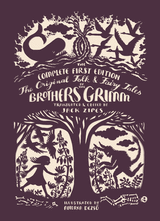 The Original Folk and Fairy Tales of the Brothers Grimm. So it turns out that what we think of as Grimm’s fairy tales comes from the 1857 edition, massively edited and re-written and a long way from the original stories. This is a translation of the first edition, in which fewer tweaks had been made to the collected stories. Some are just fragments, many are bizarre and a lot darker than the versions we’re familiar with. There are glass slippers, but not in the Cinderella story – they turn up at the ends of tales ‘and I was there, in my glass slippers’ being a way of saying ‘and this is total nonsense.’ A fascinating read, somewhat repetitive with versions of the same stories, but a must for anyone interested in fairy tales and the possible Pagan subtext of fairy tales. (I may come back and blog about this properly some other time.)
The Original Folk and Fairy Tales of the Brothers Grimm. So it turns out that what we think of as Grimm’s fairy tales comes from the 1857 edition, massively edited and re-written and a long way from the original stories. This is a translation of the first edition, in which fewer tweaks had been made to the collected stories. Some are just fragments, many are bizarre and a lot darker than the versions we’re familiar with. There are glass slippers, but not in the Cinderella story – they turn up at the ends of tales ‘and I was there, in my glass slippers’ being a way of saying ‘and this is total nonsense.’ A fascinating read, somewhat repetitive with versions of the same stories, but a must for anyone interested in fairy tales and the possible Pagan subtext of fairy tales. (I may come back and blog about this properly some other time.)
More information here – http://press.princeton.edu/titles/10300.html
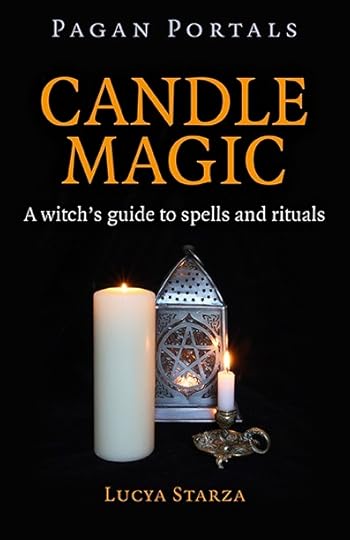 Pagan Portals Candle Magic – Lucya Starza This is an excellent little book for people starting out on a witchcraft path or interested in exploring magic. A light accessible writing style not dissimilar to Rachel Patterson, lots of things that can easily be undertaken and ways of working that can be flexed to suit your situation – broad theories of how to work rather than lots of terribly specific – and therefore often irrelevant – spells. It’s a book that encourages flexibility and creative thinking, rather than offering a set of instructions. Absolutely ideal for younger witches, and for solitary witches, but perfectly usable for anyone new to candle magic, and for group work. At the moment, spells are not a significant part of my life, but I’ve enough of a background to feel confident about saying that this is a good and useable book.
Pagan Portals Candle Magic – Lucya Starza This is an excellent little book for people starting out on a witchcraft path or interested in exploring magic. A light accessible writing style not dissimilar to Rachel Patterson, lots of things that can easily be undertaken and ways of working that can be flexed to suit your situation – broad theories of how to work rather than lots of terribly specific – and therefore often irrelevant – spells. It’s a book that encourages flexibility and creative thinking, rather than offering a set of instructions. Absolutely ideal for younger witches, and for solitary witches, but perfectly usable for anyone new to candle magic, and for group work. At the moment, spells are not a significant part of my life, but I’ve enough of a background to feel confident about saying that this is a good and useable book.
I’m running a Thunderclap campaign to draw more attention to this books, if you can loan me a tweet, tumblr of facebook post it would be greatly appreciated (it’s easy, quick and painless) – https://www.thunderclap.it/projects/37263-pagan-portals-candle-magic?locale=en
More here – http://www.moon-books.net/books/pagan-portals-candle-magic


February 3, 2016
Why you need a Tweazel
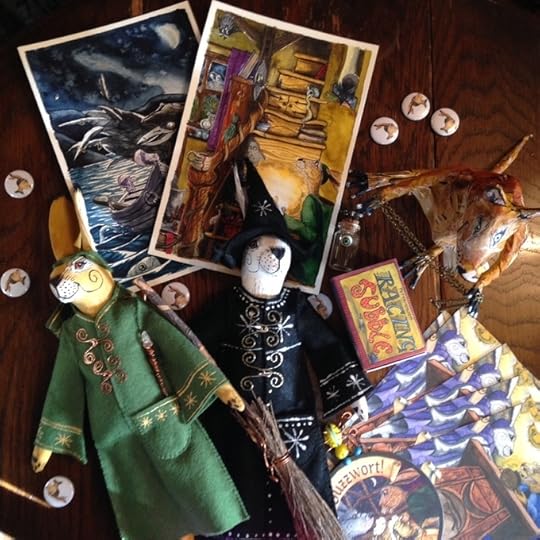 I’m a big fan of Matlock the Hare. I met Phil and Jacqui Lovesey through the medium of Twitter quite some years ago, and instantly adored Jacqui’s artwork. Through their regular posts, I met some of the creatures of Winchett Dale, got to know the magical hares at the heart of their books, and came to the conclusion that I needed to read what they’d created. I bought The Trefflepugga Path, and then The Tillian Wand, and now I’m waiting (and I’ve been waiting ages) for The Trial of the Magical Elders. I need this book. So, this is a plea – support the kickstarter because that’s how we get book three and I’m going mad with not knowing what happens next. Book 2 finished on a serious cliffhanger.
I’m a big fan of Matlock the Hare. I met Phil and Jacqui Lovesey through the medium of Twitter quite some years ago, and instantly adored Jacqui’s artwork. Through their regular posts, I met some of the creatures of Winchett Dale, got to know the magical hares at the heart of their books, and came to the conclusion that I needed to read what they’d created. I bought The Trefflepugga Path, and then The Tillian Wand, and now I’m waiting (and I’ve been waiting ages) for The Trial of the Magical Elders. I need this book. So, this is a plea – support the kickstarter because that’s how we get book three and I’m going mad with not knowing what happens next. Book 2 finished on a serious cliffhanger.
Go here (please, please) https://www.kickstarter.com/projects/...
Why, you may legitimately ask, is this fabulous book needing crowd sourcing to get published? It’s a bloody good question. The trouble is, that the main character is a talking hare, and most of the other characters are creatures. In the eyes of conventional publishing, this means it is a book for very small children and no one else could want to read it. However, the writing is grownup, and sophisticated, clever, plotty, totally unsuitable for very small children. My teenager loves these books. I love these books. The other adults I’ve bought these books for also love these books. These are great books, but they defy the rules, and so publishers won’t take a risk on them. Because, you know, Watership Down, Animal Farm, The Duncton Wood Chronicles – no one has ever written a really successful book for older readers that had talking animals in it. Umm.
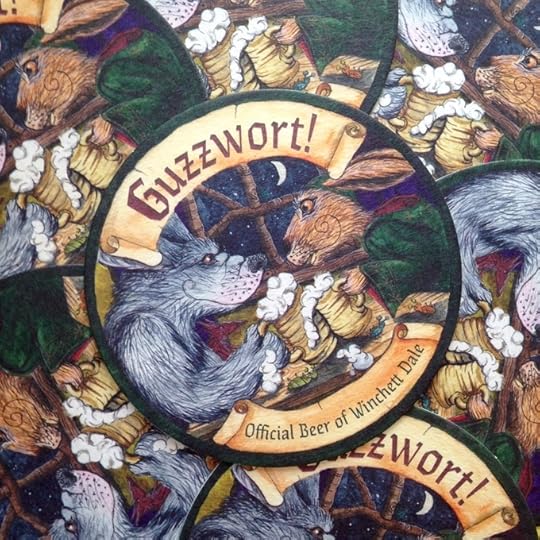 There are tweazels in this kickstarter. Alarming and simultaneously wonderful things, tweazels (the orange fellow in the image at the top of the blog). A handmade, lovely thing, there are at time of blogging, several left. I have a dripple (another denizen of Winchett Dale), I can vouch for the quality of these creations. They are superb.
There are tweazels in this kickstarter. Alarming and simultaneously wonderful things, tweazels (the orange fellow in the image at the top of the blog). A handmade, lovely thing, there are at time of blogging, several left. I have a dripple (another denizen of Winchett Dale), I can vouch for the quality of these creations. They are superb.
I need books that surprise me. I need books that take me somewhere else, and fill my head with things I’d never have thought of and get me looking at life from different angles. I need to be stretched, and unsettled and uplifted. The first two volumes of Matlock the Hare were, quite seriously, everything I have ever looked for in a book. If you’ve been with my blog a while then you probably like the same sorts of things I do. I encourage you to check out their website – http://matlockthehare.com/page/654816-books.aspx


February 2, 2016
Being an advert for your way of life
Here’s a question – would people look at you and be persuaded that your way of life is a good sort of life? Out there in the mainstream, this has everything to do with conforming to the standards laid out in adverts and in media representations. It’s simply a case of whether you look as affluent and successful and fashionable as you can. For those of us who have adopted alternative lifestyles, it’s worth wondering now and then how other people see us.
How we look tends to be a direct consequence of how we live, plus the choices we make around appearance. For the purposes of this piece I’m not talking about any inbuilt differences not subject to influence by lifestyle.
Do we want to be taken seriously? And by whom? And does that mean we need to conform to their expectations around appearance? Do we want to be seen as different, or as drop outs, social rejects, hippies, weirdoes… do we want to be accepted and respected in our differences, or do we want to be camouflaged when dealing with people who are not like us?
If we genuinely want to change things in the world, we need to persuade people that the alternatives are good and the conventions less good. We need to function as adverts for our beliefs, because we are competing with the vast advertising budgets of capitalist consumerism. If we look persuasive, we may persuade others that it isn’t all bean curd and hair shirts, and that you can live a low impact life without being miserable. If we took away the commercial advertising and judged conventional living on its consequences, people would be a good deal less persuaded by it.
When I’m walking for transport, I make a point of smiling cheerfully at the long queues of traffic I frequently pass. I generally am happy when I’m walking, I look like someone who is having a good time, and I see the faces in the slow moving cars and know that they are not. I’m the one with the freedom of the open road. However, all some people will see is that I go everywhere in walking boots and that there’s often mud around my ankles. A person for whom shiny shoes trumps everything is never going to be persuaded by me as an advert for walking everywhere.
I’m not an advert for being an author. I have no problem with this. I’m fairly representative of the 95% of authors who do not earn anything like enough to live on. We could do with a lot more realism about how the industry works, and the odds of even earning a minimum wage by writing.
We’re all of us in a constant process of expressing our values and the consequences of our way of life to everyone else – through our actions and how we look and seem. It’s worth taking a step back and wondering how you look to other people, if you’re interested in making change. Are you persuasive? Are other people going to wish they were more like you?
And if the conclusion you come to is that from the outside your way of living is not attractive or persuasive, or that no one would want the kind of life you have, there may be other questions to ask.


February 1, 2016
Steampunk Hands Around The World – Favourite Things
It’s February, the month of Steampunk Hands Around The World. The theme this year is ‘Favourite Things’ – cute little puppy dogs swimming in gin and all that. I’m going to use it as an opportunity to enthuse about some of my favourite Steampunk people, and to talk more broadly about things I love. Alongside this, there will be a fair amount of the usual blog mix as well.
Steampunk is something serious people find it hard to take seriously. It’s all about dressing up and messing about and pretending – not the proper business of reasonable adults. I’ve watched people sneer about Steampunk fiction whilst being perfectly willing to write one if they think there’s money in it. The thing is that Steampunk *is* incredibly and deliberately silly, and this is a big part of why I like it.
Life is hard for too many of us, too much of the time. The rest of the world can be terrifying, and we’re bombarded every day with more misery than we can hope to make sense of. The news is largely soul destroying. Our governments want us to work harder for less while they strip away the services we depend on. Tired people spend their leisure time resting if they can. That makes us socially isolated. It reduces our support networks and sucks the joy out of life.
We all need things that make us happy. I like Steampunk in no small part because it’s a way of people getting together and hanging out and having a laugh. You don’t have to be wealthy – some disposable income tends to help, but that’s pretty much always the case. You don’t have to spend a fortune on gear. If you can get something out of a skip and add it to something from a charity shop and something that used to belong to your Gran – you’re on the right lines.
At events there’s an emphasis on participation. You don’t go to a Steampunk gathering to be a passive consumer, and I think that’s really important.
Of course it’s not all perfect – nothing involving people is all perfect because some people are assholes and the assholes get everywhere. But on the whole, it’s a good, friendly space providing a wondrous antidote to the rest of life.
Working ourselves to death, activist martyrdom, tireless campaigning, endless fighting for rights, all out full on everything I do today has to be about saving the world… is not a sustainable way to live. Emotional collapse is inevitable. If all you do is fight, then it’s not long before you lose sight of what you were fighting for. It’s hard to keep fighting when all you do is fight against what’s wrong. It is necessary to have something to fight for.
This is why we need frivolity. We need playful spaces and community spaces, and the scope to be peacefully human with each other. We need opportunities to be happy, to be carefree, to forget all the awful stuff in the world. It’s very hard work fixing anything from a place of being broken yourself. If all we do is worthy and purposeful, we lose part of what it is to be alive, because it is human to play. We need music, and dance and stories and theatre, we need silly hats and clothes we enjoy and things that make us laugh. We need to stop trying to buy these from commercial producers and start trying to find them collectively. Having a good time without buying it off the peg is just as revolutionary as anything else you can commit to.
More about Steampunk Hands Around The World here – https://airshipambassador.wordpress.com/2016/01/13/announce-hands-2016/


January 31, 2016
Relating to the land
There are fashions in terms of how we relate to landscape. That’s been an odd concept to wrap my head around. I’ve become a reader of landscape writing over the last few years – partly because I love landscape and want to know what other people think. Partly to learn more about what I’m seeing. Partly because I have a very low opinion of authors who write without reading in the same area of thought. It is from this reading that I’ve learned about fashions in landscape appreciation.
Of course the first thing to note is that we don’t have a complete written history of landscape appreciation. Insight into historical thinking comes from travellers and early tourists – people with money and the means and time to write letters. We have the cheerful adventurer colonialist climbing mountains no one has ever climbed before, going into unknown lands. The people who live there and knew about it all along do not count. 3rd Englishman up the Matterhorn counts, but the native assistants don’t, by this peculiar way of seeing things. Had they climbed before it was fashionable? I don’t know.
Poor people tend not to write letters about their hobbies to distant friends who keep and/or publish said letters. They don’t tend to write poetry, or memoires, or how-to books, either. There’s a glorious exception in the form of peasant poet John Clare, whose love of landscape flows through page after page of observation. Was he a lone freak? Or were other men following the plough while meditating on the curve of the soil, or making verses to honour the skylark? Or women for that matter – because most of the writing that makes up history comes from men. Teaching women to write was not always the done thing, and illiterate women leave no notes on their opinions for historians to find. There is a silence then, surrounding how most people related to landscape most of the time.
Folk tales and folk songs, legends and place names can suggest very rich cultures of landscape. Unusual landscape features tend to attract tales – how many giant stones around the country are attributed to the Devil? Barrows attract ghost stories, half remembered fragments of history become legends. The thing about the people who work the land is that they tend to stay on the land, generation after generation. Things get passed down. One of the most interesting examples of this I’ve found is in Alan Garner’s The Voice That Thunders, where a story of a farmer from Mobberly who takes his horse to sell in Macclesfield but has a strange run in with a wizard, turns out to be an aural mapping of a route through prehistoric settlements. Map making isn’t always about marks on paper – they can be narratives of key features in the landscape, as with the old Parish boundaries.
The history of landscape appreciation, as written, tends to be about rich people delighting in charming novelties and the picturesque and other such ideas – more of that later. These are the views of people for whom landscape is an object to enjoy, or to find lacking. The view exists to please. A person living closer to the land is bound to have a different perspective – valuing what can be used, valuing places with ancestral connections and yes, I expect finding aesthetic pleasure too, but not necessarily having a language to express it in, or anyone making notes who would take that expression seriously.


January 30, 2016
Signs of Imbolc
Late January into early February isn’t a great time for walking in the UK – The weather is unpredictable, but tends to be unpleasant. If we’re going to get any snow at all, the odds are it will come now.
Fortunately, the vast majority of seasonal things I am interested in, are not hard to find and don’t require long or complicated walks. Snowdrops are all over the place, including on the cycle paths and towpaths that are frequently part of my routes. Little white flowers that will come up through snow, for me they are the emblem of the season. They are easy to spot as well, but they certainly aren’t the only thing waking up.
In some places crocuses will be out, and a little behind the snowdrops are the celandines – a low to the ground yellow flower. On the towpath, celandines and snowdrops are blossoming together. The blackthorn flowers about now as well – more delicate white flowers on its as yet unleafy black branches. Other fruit bearing trees also put out flowers – I’ve seen cherry and a wild plum in this last week as well. The pussy willow will be opening out its soft and fuzzy catkins, other trees have their catkins on. Anywhere that has anything by way of green spaces will likely have signs of spring as well.
The traditional association with Imbolc is lambs, and the first ewe’s milk. This is not however a time of year for seeing lambs in the fields, at least not in the UK. The lambing season has been artificially extended for a long time, for the convenience of people. Lambs born in winter are born in sheds and stay indoors until the weather picks up – which is also more about our benefit than theirs. When they go out will vary depending on the weather and when, exactly, they were born. I’m lucky in that there’s a field nearby where I can reliably see lambs most years, and I can watch out for their coming. I don’t have to take any extended walks on the off-chance of seeing sheep.
One seasonal shift that particularly affects my walking options at this time of year, is the increase of light. Back on Christmas day, being out the door at 7.30 am meant leaving in the dark, but now the sky is significantly lighter at this point. I like early morning walking when it’s quite, and Imbolc marks the time of year when I can start doing that again. I now also have some semblance of twilight, and the option of twilight walking. At midwinter when the sun sets at four, what twilight there is largely passes me by. Having twilight for a while in the evening, when I’m not working and may be out and about delights me. Not being able to engage with the twilight through the two darkest months is tough for me. The return of evening twilight means soon I’ll be seeing the other crepuscular creatures again, and this cheers me greatly.


January 29, 2016
Pagan Planet and the lives of books
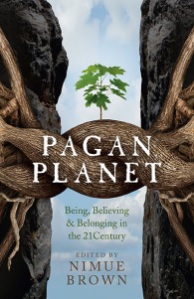 Today Pagan Planet is officially published. It’s one of the rites of passage in the life of a book – an easy one to spot. The conception of a book is generally harder to pin down. A ping moment in someone’s head – not even necessarily the author’s. Pagan Planet was originally the idea of Trevor Greenfield. Details of the conception remain mysterious! At some point, Trevor hit on the idea that a book based on the ideas of Being, Believing and Belonging in the 21st Century would be the next community book from Moon Books. He put this idea forth, and lots of people signed up.
Today Pagan Planet is officially published. It’s one of the rites of passage in the life of a book – an easy one to spot. The conception of a book is generally harder to pin down. A ping moment in someone’s head – not even necessarily the author’s. Pagan Planet was originally the idea of Trevor Greenfield. Details of the conception remain mysterious! At some point, Trevor hit on the idea that a book based on the ideas of Being, Believing and Belonging in the 21st Century would be the next community book from Moon Books. He put this idea forth, and lots of people signed up.
Around the world, lots of writers sat down with that seed idea, and contemplated their own lives and experiences, and wrote something. One seed planting many others – not all of which made it to paper, no doubt. Who knows how many more never-written volumes there are of Pagan Planet, scattered through other people’s heads?
And then, because there was a lot going on at Moon Books, Trevor asked me if I could take over holding the book process together. I was delighted to step up. I spent a lot of time contacting contributors, and also approaching people who are activists and not habitual writers. For me, that whole issue of being, believing and belonging cannot be discussed at the moment without talking about activism – political activism, and personal eco-action. I managed to lure in some great people to talk about how they manifest their Paganism. Alongside this there are some fantastic articles about other forms of lived Paganism, that reflect all kinds of interesting shifts. The democratic coven being a fine case in point.
Paganism is no longer something we can do privately for our own personal gain. We need to live our faith, and we need to be seen and heard. Many voices, just the one planet.
Some of the money from this book will be going to support Pagan Aid – which is featured in the book.
Ebook – AMAZON US AMAZON UK HIVE INDIEBOUND
Paperback – AMAZON US AMAZON UK INDIEBOUND





